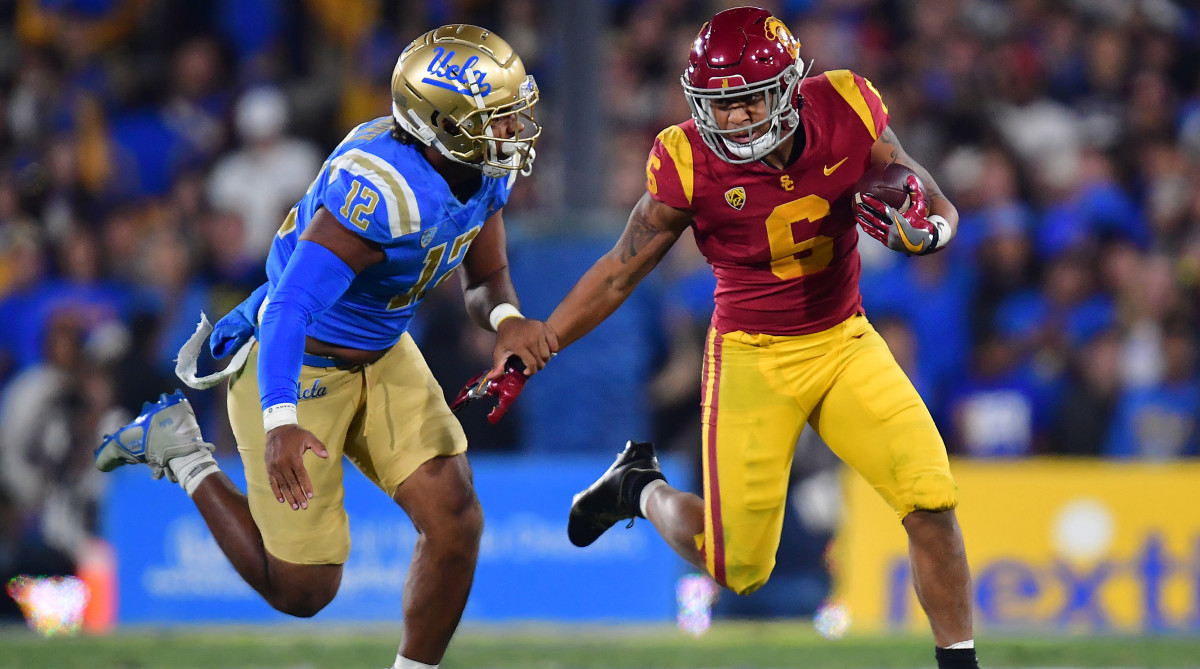Glamorous, Yes, but the New Era of the Big Ten Is Logistically Irrational

At first glance, the 2024 and ’25 Big Ten football schedules are a pure adrenaline rush of fresh excitement. Michigan playing USC in the L.A. Coliseum? UCLA coming to the Big House? Ohio State making a regular-season visit to the Rose Bowl? A division-less rotation of opponents that still preserves traditional rivalries?
Cool. Fun. New.
But let’s not forget the irrational foundation upon which this freshness is built. When it comes to the Los Angeles schools’ membership in the Big Ten, the geography still makes no sense. And the travel demands placed on the Trojans and Bruins will be a massive burden—in football and likely moreso in virtually every other sport.
USC and UCLA both will be traveling across three time zones for three of their league road games in 2024, and across two time zones for one apiece. USC will visit Maryland, Penn State, Purdue and Northwestern; UCLA will travel to Rutgers, Michigan, Iowa and Indiana. (The actual week-by-week schedule hasn’t been hammered out yet.)
Dellenger: USC, UCLA and the Big Ten: How and Why the Stunning Move Happened
For the Trojans, the land distance from campus to campus for their road games averages 2,336 miles. For the Bruins, the average is 2,240 miles. Those distances essentially double the longest road trips the schools had in the Pac-12.
USC and UCLA do play each other annually—in Pasadena in ’24, Los Angeles in ’25. That will be the first time L.A. traffic will seem like a breeze.

In addition to these new conference sojourns, USC has a game every other year in October at Notre Dame, which is another trip halfway across the country. In ’24, UCLA has a non-conference trip scheduled to Baton Rouge to play LSU.
The football teams from both Los Angeles schools certainly will take charter flights to all those road games, which will expedite travel time. And the Big Ten assuredly will do its best to avoid back-to-back road trips for the Bruins and Trojans, just as the Big 12 has worked to do that with its own geographically nonsensical member, West Virginia, whenever possible.
But those strategic moves only make it easier, not easy, for USC and UCLA. There are no transporter beams that eliminate the massive distances they will travel. There are no guarantees that late-season weather won’t snarl itineraries. There will be Friday night games with Thursday travel plans that encroach on the school week.
When the long trips add up over the months, this is going to be incredibly difficult across the spectrum. It will be difficult competitively, physically, mentally and academically. (Remember academics?)
How much this gauntlet grinds up the Trojans and Bruins over the course of a season remains to be seen. But it had better be top-of-mind for the Los Angeles schools and the conference that brought them in. They’re being asked to do a lot to line the revenue coffers.
And athletes in the other sports likely will be asked to do even more. Will midweek basketball games necessitate three days of missed class time for every trip? Will the Olympic sports teams have regular access to charter flights, or will they have to schlep their way to State College and West Lafayette via commercial flights and bus rides? How much remote learning will be implemented during road trips as a (poor) substitute for being in a classroom? How much mental health support will be offered to athletes trying to succeed at world-class academic institutions and in elite athletics while criss-crossing the country?
There are many questions that still need to be addressed amid this great money grab.
Forde: College Football’s Rich Keep Getting Richer, at a Steep Cost to Everyone Else
On the Big Ten Network show revealing the new schedules Thursday, it was noted that none of the current 14 conference schools would have to make two trips to L.A. in the same season. There was some self congratulation for that.
“We wanted to make sure we didn’t put too much of a burden on individual execution,” Ohio State athletic director Gene Smith said. “It’s effectively spread out among 16 schools. … It was important to make sure it was spread out.”
Which is great and all … except for the two new members that have four long trips to make the other direction every season. That wasn’t discussed in any depth.
The other aspects of the new Big Ten scheduling model—the so-called Flex Protect Plus plan—are all positive. The league saved every legitimate rivalry without doing so in cookie-cutter fashion—Iowa has three protected rivals, for instance, while Penn State has none. (Which is weird, but fitting. And telling. Three decades into conference membership, the Nittany Lions are nobody’s No. 1 rival.)
It figured out a plan which ensures that every member will play every other member home and away every four years, enhancing opponent variety and freeing schools like Indiana, Maryland and Rutgers from the tyranny of facing Michigan-Ohio State-Penn State every season.
And it eliminated divisions, which will end what has been an annual championship game mismatch. The East Division champion has beaten the West Division champ all nine years during the current alignment, and six of those were double-digit victory margins. Starting in 2024, it will be good-on-good, as coaches say. Even if that means Ohio State and Michigan playing on consecutive Saturdays.
So the Big Ten got the interior wiring right. But that’s within the new framework of a conference that doesn’t make sense geographically, and puts its two new members at an extreme disadvantage. Hope the revenue checks are worth the added travails, USC and UCLA.
